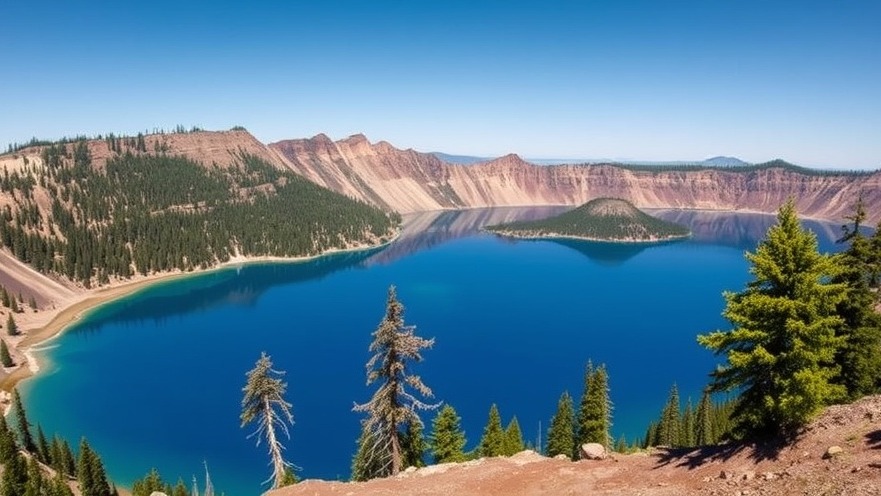
Crater Lake National Park
📍 Address: Oregon, USA
📞 Phone: +1 541-594-3000
🌐 Website: https://www.nps.gov/crla/index.htm
★★★★★
Rating:4.9
Introduction: Experience the Majestic Depths of Crater Lake
Imagine a world where nature's grandeur is defined by aquamarine depths and ancient eruptions. Such is the reality at Crater Lake National Park in Oregon. Known for its striking geological phenomena, Crater Lake earns its distinction as the United States' deepest lake, formed from the calamitous eruption of Mount Mazama over 7,700 years ago. The allure of Crater Lake goes beyond its depth; its crystal-clear waters and breathtaking views have captured the imagination of visitors, scientists, and artists alike.
Beyond its scenic beauty, Crater Lake stands as a testament to the raw power of nature and its ability to create unparalleled landscapes. Visitors to the park are not just observers but participants in a natural narrative that combines history, science, and sheer visual spectacle. As you dive deeper into this article, you'll uncover why Crater Lake is much more than a destination—it's a visceral experience that beckons nature enthusiasts and curious minds to explore its depths.
The Significance of Crater Lake: Deep Waters and History Depths
Crater Lake is a marvel in the realm of geology and environmental science. At 1,949 feet, it's the deepest lake in the United States, sustained solely by rainfall and snowmelt with no inlets or tributaries. This isolation lends the lake its purity, marking it as one of the clearest bodies of water on Earth. This geological gem resides amid the Cascade Mountain Range, capturing the essence of wilderness and the pivotal role of volcanic activity in shaping landscapes.
The history of Crater Lake is as intriguing as its appearance. The collapse of the massive Mount Mazama left behind not only the lake but also a living archive of ecological and geological evolution, witnessed by Native Americans and celebrated in their oral traditions. Today, scientists study its pristine waters to understand climate patterns and environmental changes. Tourists and researchers are drawn not only to its beauty but also to its representation of natural history, making it an impactful destination for those keen to learn about Earth's dynamic systems.
Why Crater Lake National Park Offers More Than Just Scenic Views
Crater Lake National Park isn't just about majestic vistas; it offers a series of compelling benefits that enrich visitors' lives. The park provides a year-round playground for adventurers, with activities ranging from challenging hikes along the infamous Cleetwood Cove Trail to serene snowshoe walks guided by park rangers during winter months. These activities provide visitors with a deeper connection to nature and the thoughtful preservation efforts that maintain the park's pristine conditions.
Engaging with the park's diverse ecosystems—from its alpine meadows to the clear waters of the lake—provides an unparalleled outdoor education. It allows individuals to witness the importance of conservation and the impact of environmental preservation first-hand. While it invites moments of introspection and awe, the experience at Crater Lake enriches visitors' understanding of ecological balance and the pressing need to safeguard such natural treasures for future generations.
The Joy of Winter Exploration at Crater Lake
While summer draws crowds to Crater Lake National Park for its traditionally warm-weather activities, winter offers a unique charm that transforms the scenery. Covered in snow, the landscape becomes a wonderland that is as captivating as it is serene. Visiting in winter means fewer crowds, the silence of snow-covered trails, and opportunities for activities such as snowshoeing, which unveil a different facet of the park’s beauty.
The park provides guided snowshoe walks, which not only introduce visitors to winter wildlife but also educate on the park's adaptation to seasonal changes. Winter visitors gain insight into the diversities of ice and snow environments, further enhancing the park's value as a year-round natural museum. So, while gaze-worthy views remain a constant, winter amplifies the park’s capacity for solitude and reflection.
Practical Tips for Making the Most of Your Crater Lake Visit
Preparing for a trip to Crater Lake National Park requires more than just packing a camera. The park's weather is famously unpredictable, so visitors should check forecasts regularly, as conditions can swing from sunshine to intense snowfall within hours. For those traveling with pets, it's essential to understand the designated pet-friendly zones within the park to ensure a safe visit for both pets and wildlife.
Navigating the park’s stunning but formidable trails calls for solid preparation. The Cleetwood Cove Trail, for instance, is known for its challenging elevation changes, and being equipped with proper footwear is crucial. Additionally, exploring the park via trolley and boat tours can offer a new perspective, providing both convenience and comprehensive information from knowledgeable guides who offer insights into the park’s geology and conservation efforts.
Crater Lake National Park's Commitment to Conservation and Education
Crater Lake National Park embodies a profound dedication to conservation and environmental education as a result of its unique geological features and pristine ecosystems. The park's mission revolves around preserving its natural beauty while providing educational experiences for visitors. This dedication is reflected in their comprehensive programs that delve into the park’s history, volcanic origins, and the efforts taken to protect its fragile ecosystem.
The park’s philosophy centers around fostering a sustainable balance between visitors and nature. By encouraging educational tours and promoting conservation awareness, Crater Lake plays an active role in shaping responsible tourism. It presents an educational lens through which visitors can learn about the park's delicate ecosystems, the importance of air quality monitoring, and the impact of human visitation on preserving natural environments.
What Visitors Say About the Unforgettable Crater Lake Experience
Exploring Crater Lake leaves an indelible impression on its visitors, creating lasting memories and a deep appreciation for nature's grandeur. Many past visitors attest to the breathtaking beauty and unique experiences the park offers.
I don't have words to describe how beautiful this place is. The lake is the deepest lake in the United States. The water is clear and fresh. The mountains that surround the crater are beautiful, snow-capped peaks. It starts snowing early up this high and the road that circumnavigates the crater doesn't get cleared, so I recommend you come in the summer months if you want to do the scenic drive around the lake. This place, like all national parks, is absolutely worth the trip. Sure to not disappoint.
—Andrew M.
The experience shared by visitors like Andrew M. highlights how a journey through Crater Lake National Park offers more than picturesque views; it provides a deep connection to the natural world that words alone cannot encapsulate. For those eager to experience such wonder, Crater Lake promises an adventure worth taking.
The Lasting Impact of Exploring Crater Lake’s Natural Beauty
Crater Lake National Park isn't just a landmark; it's an embodiment of nature's raw power and delicate beauty. Its role in education and conservation highlights how significantly it contributes to the understanding and appreciation of Earth's geological and ecological processes. Through informed exploration and conscientious tourism, the park demonstrates the profound importance of preserving our natural landscapes.
Crater Lake stands not only as a stunning geographic feature but as an emblem of commitment to preserving the Earth's wonders. Visitors are encouraged to engage deeply with the park, gaining insights into both its natural offerings and the storied history that has shaped its present. As you plan your next nature excursion, consider stepping into the awe-inspiring depths of Crater Lake National Park, where every visit is a lesson in beauty and balance.
Contact the Experts at Crater Lake National Park
If you’d like to learn more about how exploring Crater Lake National Park could enrich your understanding of nature's wonders, contact the team at Crater Lake National Park.
📍 Address: Oregon, USA
📞 Phone: +1 541-594-3000
🌐 Website: nps.gov/crla/index.htm
Crater Lake National Park Location and Availability
🕒 Hours of Operation:
📅 Monday: Open 24 hours
📅 Tuesday: Open 24 hours
📅 Wednesday: Open 24 hours
📅 Thursday: Open 24 hours
📅 Friday: Open 24 hours
📅 Saturday: Open 24 hours
📅 Sunday: Open 24 hours

 Add Row
Add Row  Add
Add 




Write A Comment